MICROFORESTRY
Something to Do
During a sunny, cold day a few years ago, I was itching for something to do outdoors. I already had piled mulch on top of last year’s mulch beneath the blueberries, the vegetable plot was weed-free, and I usually defer pruning until later in winter. So what was there to do? I decided to clear some “forest.”
Actually, the forest was one mulberry tree, a seedling that had grown up in the wrong place, but which I had neglected for a few years until its trunk had a girth of eight inches. I had cut back the top the summer previous to at least slow its growth. But it was time to emulate on a small scale one of the tasks of the early settlers here: digging out the stump.
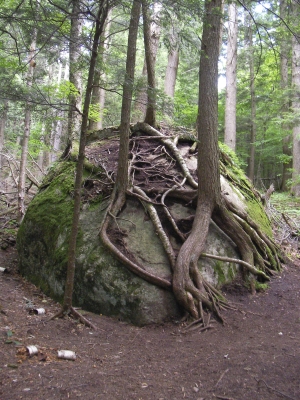
Tree roots in the Adirondacks
Before I began, I gathered up what I would need for the job: a spade whose blade I sharpened with a file; a pruning saw; a pry bar; and some fill soil. But first let’s backtrack a moment. When I lopped back the tree the previous summer, I had cut off all the branches and left a single trunk about five feet tall. A length of trunk provides a handy lever for working a stump out of the soil.
I began by digging soil away from the base of the tree, going around and around the trunk, deeper and deeper. My spade was frequently jarred to a stop by thick, horizontal roots. I dug under and around each one to expose as much of it as possible, then sawed through in two places a couple of inches apart. Why two cuts? Previous experience taught me that the cut ends of a single cut would stay wedged together almost like an intact root when I later tried to pull the trunk over. With two cuts, I could knock out the piece between the cuts and avoid binding.
Besides getting my blood pumping and getting rid of unwanted trees, another benefit of digging out stumps is the interesting relics that sometimes turn up buried in the soil. During the course of digging, I uncovered a dinosaur. This one was about three inches long, a green plastic brontosaurus.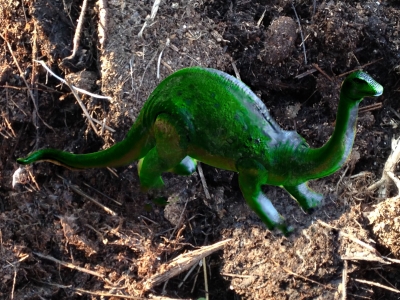
Anyway, I continued around and around the tree, sawing large roots and chopping small roots with the spade. At this point, I could push the trunk partially over in any direction, which I did to further sever any roots.
Next comes the hardest part of digging out a stump. Some roots of a tree grow straight down from the trunk into the soil. These roots are hard to reach with a saw. My procedure was to bend the trunk over as far as possible, helping it along and levering it over with the pry bar. Then, with a combination of what small jabbing cuts I could make with the saw, and what chips I could gouge out with the spade, I cut the downward growing, large roots.
Finally came the sense of accomplishment as the trunk and roots were finally free of any connections to the ground. I filled the gaping hole with some soil, tamped it down, and gave it a thin covering of wood chips to keep the soil from washing away.

Aerial roots, which drop to the ground to take hold, of tropical fig species
With a Little Help from a Friend & a Tractor
I’ve become more efficient at “forest clearing” since those early forestry days. Case in point was a hazelnut plant I removed a few months ago. (The nuts this particular plant bore were few and small.) Although only seven years old, this multi-trunked tree/bush was hefty.
I began as in the past, this time helped along even better with a maddock. That, combined with the pry bar, and more digging, and root pruning, as well as, this time, the help of a reciprocating saw having a pruning blade, I was better able to eat away at the root ball. Still, though, some large roots, deep down, anchored the plant firmly to the ground.
At this point I wrapped a heavy chain around the sturdiest trunks — high enough on the trunks for good leverage but not so high as to allow the trunk to break — and pulled on it with my tractor. The rootball and attached trunks satisfyingly rose up and out of the ground, helped along by a friend who stood ready to cut still attached roots here and there.
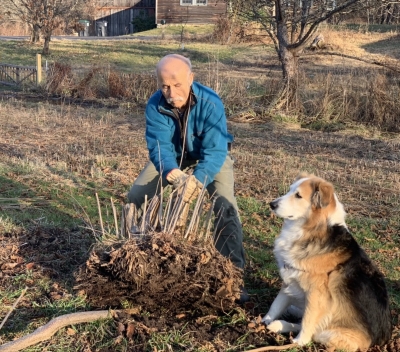
Sammy’s not much help here
Appreciations
Even on a small property, trees sometimes are in the wrong place and need to be removed, stump and all. Digging out even one tree gives an appreciation for the efforts the early settlers had to expend to clear land for their gardens.
I’ve watched giant bulldozers clear forests, so hand digging also gives me an appreciation for the sheer power of modern machinery, and, conversely, how much productive physical exercise we are spared — or deprived of.
When you dig out a tree, you also better appreciate their roots — their thickness, their extent, even their color. My mulberry’s roots were bright orange — a sight even even more unexpected than that of the brontosaurus.
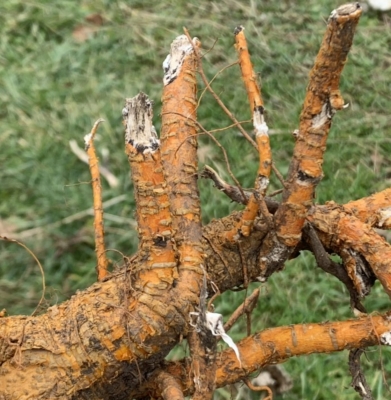
Mulberry roots


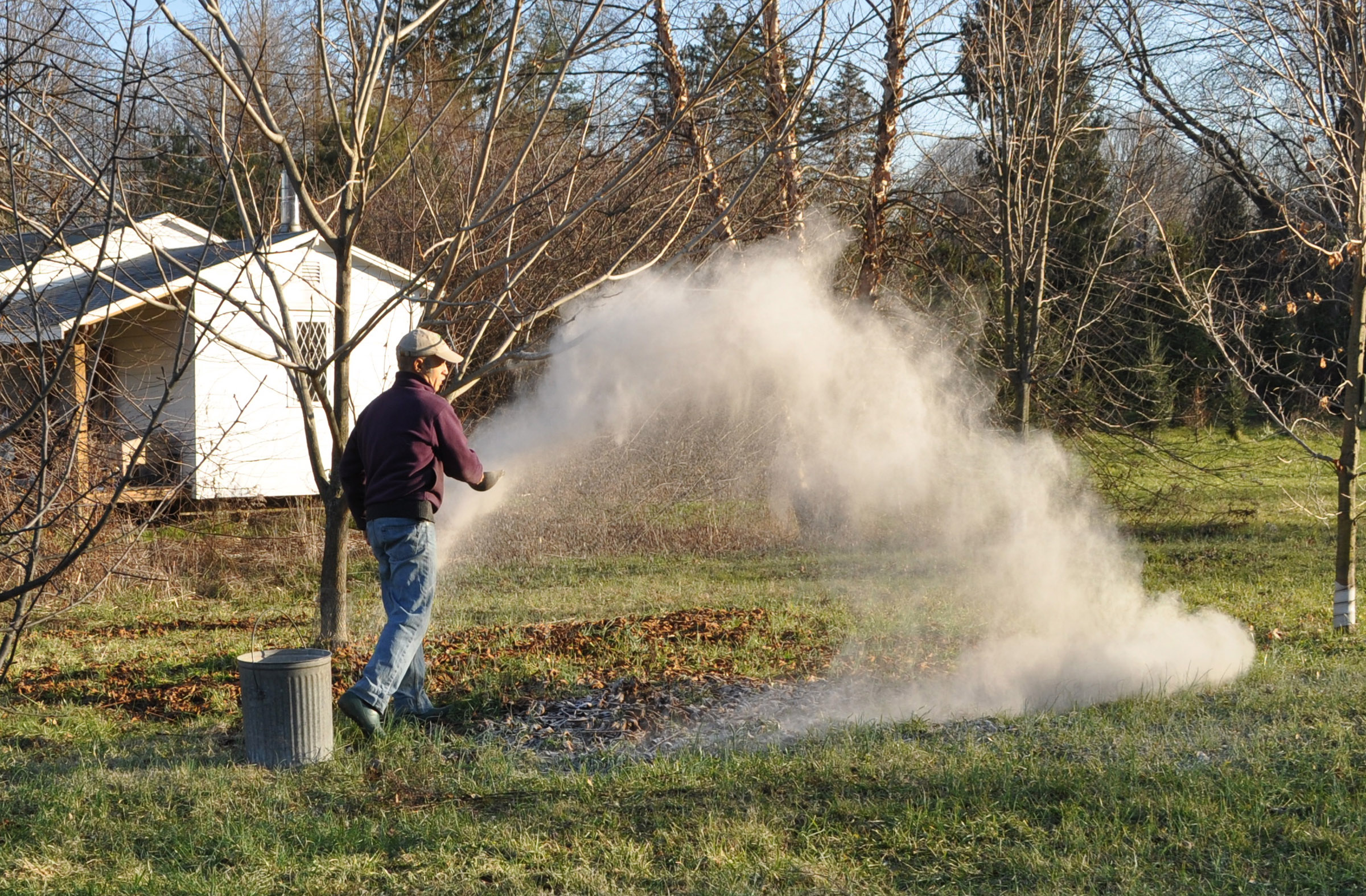
Lee,
Great pictures and how to remove an unwanted tree/stump. I finally bought a Pulaski Axe for small tree and shrub removal about 16 years ago. It
works like a charm cutting the tree roots. I’ve borrowed friend’s weed wrench. I don’t have a tractor so I improvised with a good come along and old
tow, logging chains, and a poly strap to wrap around the larger tree I use for support. Amazing how those chores pile up
His Lew, Yeh, that Pulaski axe is very similar to my using a maddock and, I forgot to mention, a double bit axe whose narrow, sharp edge cuts through roots nicely. Weed wrench didn’t work so well for me. By the way, still growing mulberries? Birds get all mine except for the year when we were overrun with cicadas.
Everyone asks “what’s your favorite flower” or “what’s your favorite tree?”
Nobody ever asks “what’s your favorite root?”
My answer is rhubarb, followed by the satisfaction of a really clean pull of a malva neglecta.
Rhubarb ROOT?! What’s good about the root?
Do you keep many mulberry trees? I would think a nice mulberry would keep birds off your blueberries!
I do have two mulberry trees. In my experience, having mulberry trees just gives more birds more to eat.